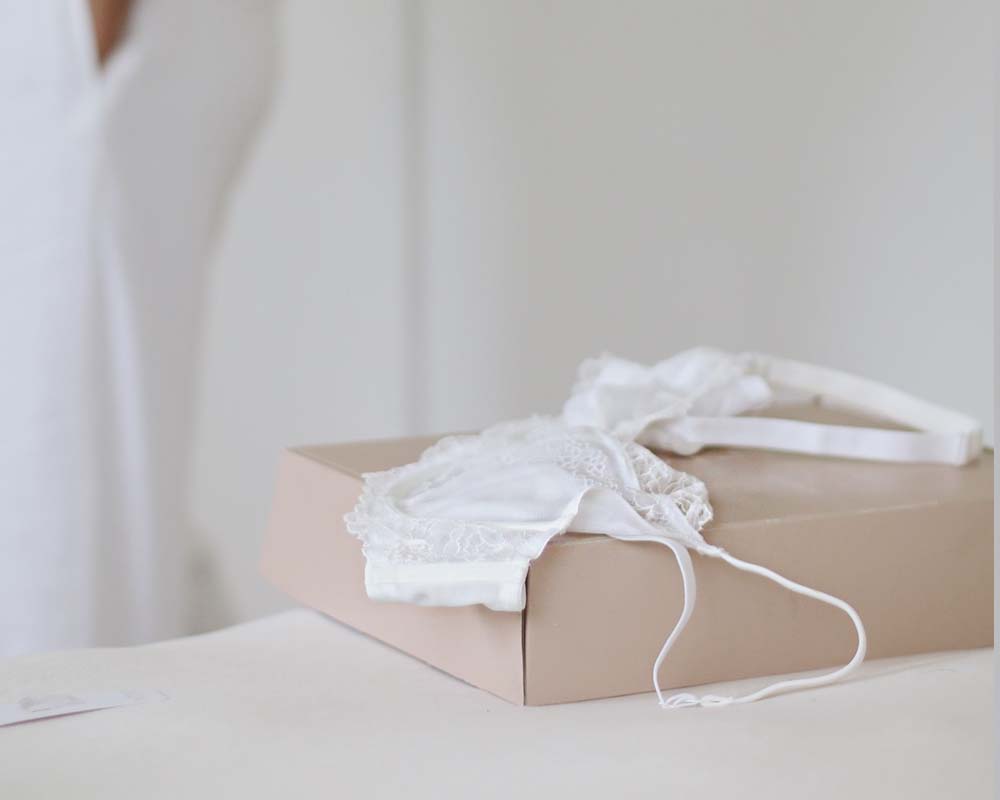Be Breast Aware
Being familiar with what’s normal for your breasts and checking them regularly can help you detect changes early, when breast cancer is most treatable.
Every Intimo Bra comes with a breast check card as a reminder to check your breasts each month. Early detection of breast cancer can save your life, so place this card close by as your visual reminder to be breast aware.

STEP 1: CHECK YOUR BREASTS LYING DOWN
Before getting out of the bed in the morning, take the time to check your breasts. Lying down spreads the breast tissue more evenly across the chest wall, making it easier to detect any unusual lumps or abnormalities.
Lie on your back with one arm behind your head. Use the pads of your fingers on the opposite hand to check your entire breast and armpit area - from the breastbone across to the armpit, and the top of your collarbone to the bottom of the breast.
Move your fingers in circles starting at the nipple and working outward, or use an up-and-down motion as though you were mowing a lawn.
Ensure you apply light, medium, and firm pressure to feel all tissue layers. Check the nipple and gently squeeze for any discharge. Repeat on the other side.
STEP 2: CHECK YOUR BREASTS IN THE MIRROR
Stand in front of a mirror in a well-lit room with your arms relaxed by your sides and carefully observe your entire breast area.
Look for changes in size, shape, or colour. Watch for visible differences such as dimpling, puckering, skin changes like redness, rash, or soreness, as well as any alterations in the nipples, including inversion or discharge.
Next, raise both arms above your head. This position may reveal changes in the shape or contour of your breasts that aren’t visible when your arms are down.
Then, place your hands firmly on your hips and lean slightly toward the mirror. This movement tightens your chest muscles, making subtle changes easier to see. Slowly turn from side to side to check the outer areas of your breasts.
STEP 3: CHECK YOUR BREASTS STANDING UP
Examine your breasts in the shower, where soapy skin allows your fingers to glide more easily over the breast tissue.
Raise your right arm and use your left hand to check your right breast for any changes. Repeat on the other side.
Regular breast self-exams at the same time each month, together with clinical examinations and routine mammograms, are vital for the early detection of breast cancer. They empower you to take a proactive role in recognising changes and seeking timely care.
If you notice anything unusual, it is important to contact your doctor promptly for further evaluation.
FAQ's
In Australia, 1 in 7 women develops breast cancer in their lifetime. In New Zealand, it is 1 in 9.
Breast cancer is the second most commonly diagnosed cancer.
Survival rates for breast cancer diagnosed at earliest stage are over 90%, versus just 15% when diagnosed at stage 4.
Breast Awareness and prompt evaluation of changes remains the safest and most evidence-backed approach.
Whilst three-quarters of females believe they are breast aware, only around 16% actually possess the required skills and knowledge, which is why it is critical that females are educated on how to understand what is normal, and what is not.
A breast check is simple and can be done in just a few minutes. It involves studying your breasts lying down, in a mirror and in the shower so you are familiar with their regular appearance and feel.
Being familiar with what’s normal for your breasts and checking them regularly can help you detect changes early, when breast cancer is most treatable.
Use Intimo's '3 Step Check' to perform a thorough self-check each month.
A week after your period has ended is the best time. Pre-period isn’t ideal as your breast tissue undergoes cyclical changes like tenderness and increased lumpiness. This state is not indicative of what you normally feel like, so it is important you check your breasts at the right time.
Women aged 40+
If you don’t have any breast symptoms, you can book a free mammogram every 2 years through BreastScreen. Women with symptoms should see their GP.
Women aged 50 to 74
You’ll receive an invitation from BreastScreen every 2 years to have a mammogram. More than 75% of breast cancers are in women aged 50 to 74 so this group is targeted.
People at any age who have increased risk
You may be offered free mammograms each year if you have an increased of developing breast cancer, for example because of a family history.
People at any age who have very high risk
If you are very high-risk, for example due to genetic mutation, you should talk to your GP about a more tailored screening program. This may include more regular imaging (MRI) at a private imaging clinic, outside the BreastScreen program.
For women under 40
Mammographic screening is less effective in detecting breast cancer before 40. If you’re concerned you may have a higher risk of breast cancer, you should talk to your GP. A breast ultrasound or MRI may be better.
‘Normal’ is different for everyone. It is completely normal for a woman’s breasts to differ slightly in size, shape and position. Light pain is very common, often harmless and easily treated with medication. So are benign cysts and tissue that is naturally more lumpy or denser than others.
Tenderness and increased breast size before a period is normal, too. Contraception can also increase breast pain. The important thing is to get familiar early on with what your breasts look and feel like at different times of your cycle, so you can spot any changes more effectively.
While the causes of breast cancer are still unknown, common risk factors include: ageing, family history, inherited genetic mutation like BRCA 1 or BRCA 2, exposure to female hormones (natural and administered), lack of exercise and poor diet, obesity and excessive alcohol consumption.
Common symptoms of breast cancer can include thickening breast or underarm tissue, new lumps, sore nipples or nipples that start to invert and produce discharge, dimpling or puckering breast skin, rash or swelling and redness on the breasts. It is important to note that pain is a rare symptom of breast cancer.
If you notice anything unusual, it is important to contact your doctor promptly for further evaluation.
All information gathered from Dr. Amber Hart, the National Breast Cancer Foundation and the New Zealand Breast Cancer Foundation.
Please note: the information on this page is intended purely as a guide, not to replace qualified medical advice. Your first source of medical knowledge and help should always be your doctor. See your GP if you have any concerns.
Some helpful material can be found on these sites:
NATIONAL BREAST CANCER FOUNDATION
